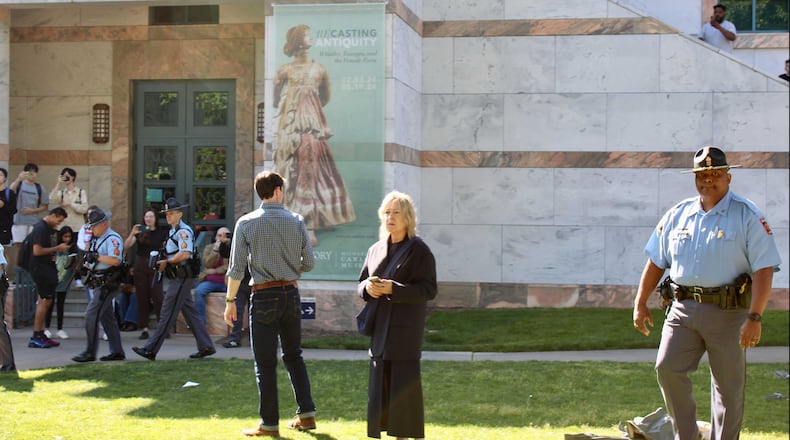What do you see when you see college students gathering on the grass? Or sitting around some tents they’ve pitched, occasionally chanting political slogans? I don’t mean just the visuals, but what it means to you.
A year ago today, I wandered onto my university’s quadrangle to observe such a gathering. I saw happy students. I saw people milling around on a glorious spring morning. I saw a brilliant blue sky. It was all idyllic — except ominously Atlanta police officers were massing with Emory University police in the far corner. And then I saw a platoon of Georgia State Patrol troopers marching down the other side of the quadrangle in my direction. As they neared, the air seemed to get sucked right up into the sky, as if it needed to find a better place in a hurry. Then the chanting turned into screams: Everybody Run! Everybody Run!
What did I see when I saw the GSP enter my campus and take position from the heights of of the Carlos Museum, long guns trained on the students? I think I saw, or felt in my bones, the ghosts of over a century of state power long aimed at quelling any hint of unruliness. What were they doing here?
Credit: Con
Credit: Con
What did the police see? I know from reading police reports that they saw not students but trespassers, potentially violent offenders who needed to be rounded up before they could run, to be tackled and zip-tied, and carted off to waiting police wagons.
A few seconds after the GSP took position, mayhem ensued, all recorded for the world to see.
What did people scrolling through their news feeds see that day? Images of police tackling and tasing students who were mostly Black or brown, many wearing kaffiyehs, sounds of pepper spray, rubber bullets, heads being bashed to the ground, screams and wails. There was also a clip of me, the chair of the philosophy department, being dragged by an APD officer in a balaclava to a police wagon.
What did viewers see in all of that? What they saw has as much to do with their own ancestral trauma, unconscious memory traces, and cultural values as it does with the actual images. One person’s peaceful protest is another’s violent riot. For one person, a demonstration may be calling for peace, and to another that very same event can be perceived as an existential threat. Some interpret the mere presence of a kaffiyeh as antisemitic. Others see it as a struggle against genocide.
Watching the news of the Emory protest from her hometown, Josseyln St. Claire, who had just been admitted to Emory, took in the images of “protesters avoiding pepper balls while police shoved students and faculty to the ground,” as her mother hovered over her saying, “You will not get arrested.” St. Clair wrote in The Emory Wheel that she was transfixed by what she saw: “... the people that our history textbooks will come to honor, people who have given up everything because they know what is at stake.” She imagined her future self on the Quad with a picket sign in hand. “After all, history looks kindly on people who sacrifice everything in the face of injustice.”
But in her first year at Emory there have been few protests, perhaps due to how hard Emory clamped down and clarified what it would not tolerate. Eventually, even when the occasional protest ensued, fear kept her at a distance.
Now I see that the ghosts of the GSP did truly enter my campus. Emory, along with other universities across the country, has become very good at tamping down on any unruliness. Universities have honed stronger instruments for controlling their students, from increased surveillance, tougher student conduct codes, and even revoking degrees. Emory loves to quote John Lewis’s notion of “good trouble” but fails to see the good that it can do. At best, Emory’s administration tolerates it but never encourages it. Students know very clearly, thanks to a new open expression policy that I helped draft, what kind of actions might land them in jail. But along with that clarity there is a heightened awareness that there is still nothing that prevents a university president from calling in the police on a peaceful student demonstration. No matter how carefully one follows policies, any misstep or misinterpretation could get you dragged to a police wagon. And today it might even land you in a Salvadoran prison.
And yet, on this one-year anniversary of last spring’s assault on our students, I expect that today a good number of students will step out on the grass. They will speak up for what they believe in because, as St. Clair writes, “they know what is at stake.”
When you see those images, what will you see?
Noëlle McAfee is professor and chair of the philosophy department and president of the university senate at Emory University.
About the Author
Keep Reading
The Latest
Featured



